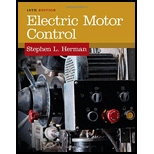
Concept explainers
What characteristic of wound rotor motors led to their wide use for industrial applications?
State the characteristics of wound rotor motors that led to the wide use for industrial applications.
Answer to Problem 1SQ
The speed or torque control characteristics of wound rotor motors are led to the wide use for industrial applications.
Explanation of Solution
The wound rotor motor is the first AC motor provided with the speed control characteristics. The wound rotor motor is widely used in industrial power applications since it provides the wide range of speed control. In addition, wound rotor motor has features of high-starting torque and low-starting current. These features are highly necessary to provide the motor better operating characteristics to use for applications where a large motor is required or where the motor must start with load connection.
Conclusion:
Thus, the speed or torque control characteristics of wound rotor motors are led to the wide use for industrial applications.
Want to see more full solutions like this?
Chapter 34 Solutions
Electric Motor Control
- 7.48 Determine the Thevenin equivalent of the circuit inFig. P7.48 at terminals (a,b), given thatVs(t) = 12cos 2500t V,Is(t) = 0.5cos(2500t −30◦) A.arrow_forward1. In the following closed-loop system, a PD controller of the form K(s + 5) is used. Design the gain K such that the system achieves an overshoot of 16%. Calculate the settling time and peak time for the PD controlled system. Compensator R(s) + E(s) Plant 1 C(s) K(s+Zc) (s+1)(s+2)(s+5)arrow_forwardFind Voarrow_forward
- 3. Use MATLAB to generate the Nyquist plot for the following system. Then, apply the Nyquist stability criterion to determine the range of K values that ensure the stability of the closed-loop system. R(s)+ K C(s) (s+2) 1 (s + 4)(s+6)arrow_forward4. Please find the stability margins from the following Bode diagrams. Bode Diagram Phase (deg) Magnitude (dB) 50 -100 -90 -135 -180 -270 10" 10° Frequency (rad/sec) 10'arrow_forward2. Please use asymptotes to draw the Bode diagrams of the following transfer function. Please label the axes to show the cut-off frequencies and key values on vertical axes and label each asymptote with its slope. G(s) s+10 s(s²+10s+100)arrow_forward
